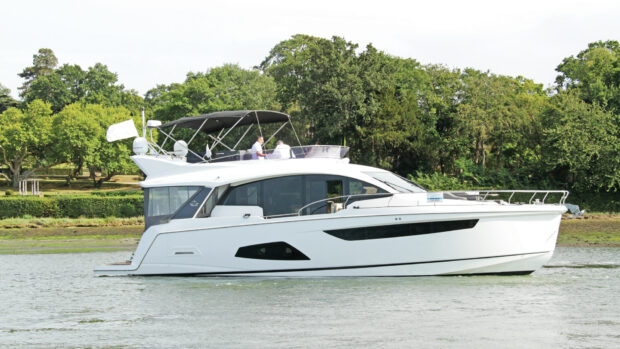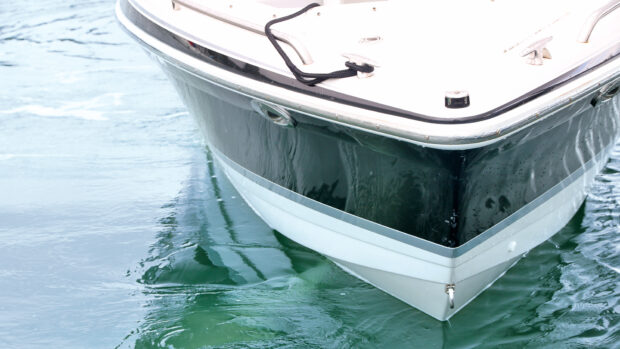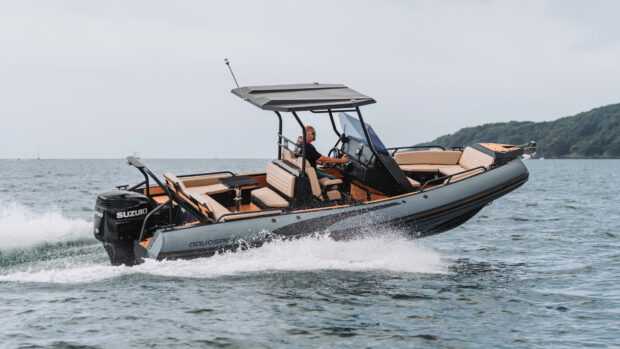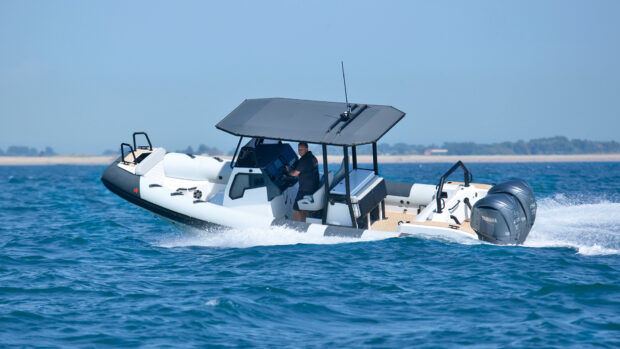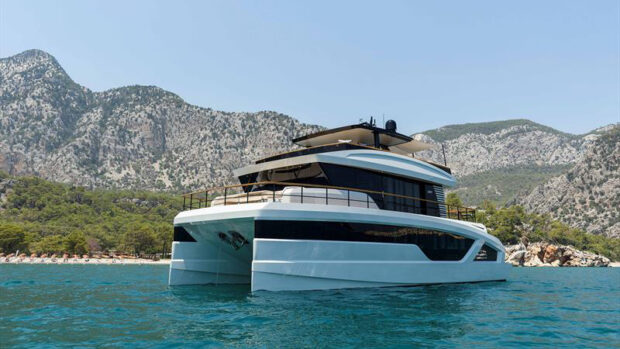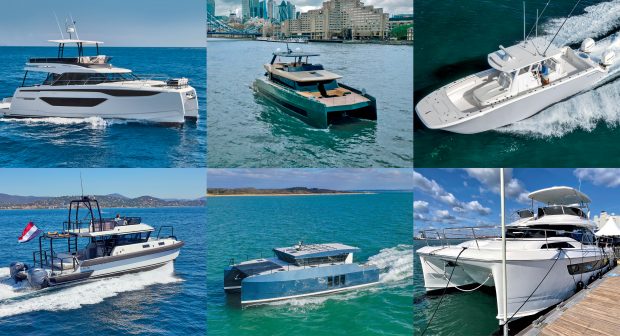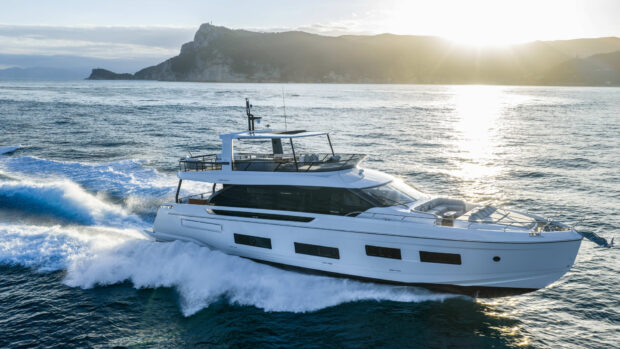The wallywhy100 may be the smallest model in the wallywhy range, but it looks suitably arresting and it's a novel take on a dayboat with the potential for longer cruises
Different and uncompromising. Not qualities that you would necessarily associate with relaxing days out on the water, yet these are precisely the words which Wally Yachts has chosen to sum up its latest model: the wallywhy100 (and yes, that is how they like to spell it).
It’s a brave call but then so is everything Wally does – you don’t become one of the most admired brands in yachting by simply following the herd.
Then again, being different doesn’t necessarily mean being better, any more than being uncompromising does. But before we put the wallywhy100 through its paces to decide whether it is good-different, bad-different or merely indifferent, a word or two about its place in the Wally firmament.

The flip side is a much longer, more sheltered main deck for guests to enjoy regardless of weather conditions
Form and function
The 100 is the third and smallest model in the wallywhy range but unlike the original wallywhy200 and 150, both of which were tri-deck cruising yachts designed to maximise internal accommodation, the wallywhy100 is a two-deck boat with a strong emphasis on daytime entertaining rather than overnight cabin space. In that regard it acts as a crossover model between the sleek, paper dart style and high-end performance of the wallypower range and the tall, voluminous, cruising-oriented wallywhy offerings.
Article continues below…

Wally WHY150 yacht tour: Inside the ultimate designer space ship

Wally WHY100 first look: The new fast planing baby of the crossover range
What it does share with its larger wallywhy siblings is its distinctive cab-forward design, its semi-displacement hull form and its quirky naming policy (the 100 is only 70ft long).
The reasoning behind these counterintuitive decisions is logical enough; by pushing the windscreen and helm further forward than usual, it frees up more space behind it for guests to enjoy. On a conventional 70-footer, the windscreen would typically be around 25ft back from the bow, leaving around 45ft behind it for the helm, saloon, galley, cockpit and bathing platform to share between them.

The cab-forward design means the outdoor bow lounge is small by 70ft standards
On this boat, the windscreen is only around 10ft back from the bow so there’s fully 60ft left for entertaining space. Of course it’s not quite as one-sided as that because most modern 70-footers now make use of that foredeck area to fit a big outdoor bow lounge but you get the idea.
That helm-forward design is also one of the reasons it uses a semi-displacement hull form rather than a planing one, as the closer you are to the bow on a planing boat, the more pitching and slamming you will experience.
By opting for a semi-displacement design that pushes through the waves rather than skipping over them, you mitigate much of that potential discomfort. Even the numbering policy was based on logic as it referred to the gross tonnage (the internal volume) of the original wallywhy200 rather than the length, although we’re not certain if this is still the case with the wallywhy100. So much for the theory but what is it actually like at sea?

Folding side terraces and a lowering central section of the aft platform provide great connection with the sea
Inside out
The first thing to note is that almost the entire length of the main deck is on one level, connected by broad, deep, well protected side decks that makes it very safe and secure for guests of all ages to move around. There are a couple of low steps leading down to the hydraulic aft platform but they are so long and so shallow that you barely even notice they’re there.
Even the bathing ladder is unusually easy to use, being a convertible passerelle that slopes gently down into the sea in a series of teak steps with handrails on both sides.
The other thing to point out is that the main deck is broken down into four separate zones, each with different roles and varying degrees of shelter. The beach club at the stern and the tiny foredeck lounge are the only truly ‘outside’ spaces and even then the hardtop extends a good way aft.
In between there’s a semi-enclosed area for dining and cooking and a fully enclosed one for the saloon and helm. It’s a clever solution that allows you to use most of the boat most of the time without ever getting too hot or too cold.

The lower chaise longues can be swapped for a raised sunbed with a tender garage underneath it
Each of these zones has its own specific purpose. The open aft end is the beach club area comprising a large hydraulic platform that lowers down into the sea to launch and recover the tender. Either side of this, two big sections of bulwark fold down to extend the beach club out sideways and improve the view from the central sunbed.
Underneath this is a large storage locker for water toys, cleaning gear and fenders. There is also an option to fit a taller sunpad with a proper garage under it if you would rather keep your tender stored out of sight.
The next level up features a pair of fixed aft-facing settees tucked into each corner of the cockpit. These are a great spot to hang out as they are sheltered from the wind, sun and spray by the main superstructure and the overhanging hardtop.
They are long enough to stretch out on and admire the wake churning out behind the boat but also tall enough to sit upright along each side for a more convivial chat at anchor. Our only criticism is that there is nowhere in this outside space where you can sit facing forwards under way.

Clear acrylic side doors can be opened up for more authentic al fresco dining
Al fresco dining
On the same level as this but separated on our test boat by a pair of lightweight sliding clear acrylic doors is the guest cooking and dining area. Another set of sliding acrylic doors along each side provide yet more protection when needed but you can either open them up or delete them altogether if you want a more open feel. The joy of these sliding doors is that it gives the feeling of eating outside while enjoying full protection from both the sun and wind when needed.
It’s no surprise that one of the first wallywhy100s was bought by a celebrity chef, as this is both the physical and metaphorical centre of the boat, featuring a circular dining table (always the most sociable shape for small groups of people) and a two-part outdoor galley you can spec-up with all manner of kitchen equipment from hobs and grills to sinks, fridges and icemakers.

The black mullions and roof supports do look cool but dominate the view out for guests and helm
A second, much sturdier set of sliding steel and glass doors lead forward from here to the saloon, providing even better insulation from the weather and noise of the engines. All this zoning means that the saloon itself feels relatively small for a 70-foot boat, not helped by the thick matt-black mullions and superstructure mouldings which dominate the view out.
It’s all part of Wally’s über modern design ethos with its highly stylised angular shapes, faceted glazing and high contrast colour schemes, but it can feel a little overbearing after the much lighter, more open aft end. At least here, the natural teak sofas and textured fabrics add some much needed softness and curves to the saloon.
Last but not least is a tiny foredeck lounge with a couple of small sofas and access to the deck gear and ground tackle. It’s no match for the vast sprawling sunpads and U-shaped dinette you would find on something like a Pardo GT75, but it does provide an extra outside spot for a more intimate gathering away from the main party spaces.

Strips of white banding add visual interest to the fabulous full beam owner’s cabin
Sleeping beauty
The wallywhy100’s primary role may be as a glorified dayboat but there’s plenty of scope for longer cruises. The lower deck is divided into a self-contained crew area forward, accessed via its own staircase next to the helm, and the guest area aft, again with its own staircase leading down from the saloon. A discreet interconnecting door between the two does allow crew direct access to the guest spaces for turning down beds and so on but for most of the time you would never know they were there.
Having the galley as part of the crew area also means they have more space to hang out in the evening without being confined to their sleeping quarters – a fairly compact two-berth bunk room albeit with a decent ensuite bathroom. Our only gripe with the galley is that the eye-level lockers not only block out much of the view from the hull window but also overhang the work surface at head height, making food prep more awkward than it could be.

The VIP cabin may be rather boxy in shape but is saved by its elegant detailing
The guest cabins are considerably more lavish, albeit in a very understated, almost minimalistic way. Perfectly sited at the foot of the companionway is a stylish day heads that doubles as the ensuite bathroom for the smallest of the three cabins – a very respectably sized twin with good headroom and a lovely big hull window.
The square-shaped VIP opposite could come across as rather box-like but thanks to a vast picture window, a curved bedhead and a clever contrast between the band of golden teak panelling and pale alcantara coverings that wrap right around the deckhead, it never feels that way. The one thing we’d like to change are the flush-fitting door handles, which look great but proved fiddly to use and prone to sticking.
The star turn is reserved for the owner’s suite at the aft end of a rather long, featureless corridor. Spread across the full beam of the boat but with the port side given over to a stylish ensuite, it enjoys views out on both sides of the bed through the bathroom’s seemingly transparent glass bulkhead and doors. These look a little milky, almost as if they haven’t been cleaned properly, because they’re made of special privacy glass that turns opaque at the flick of a switch to preserve the user’s privacy.

Even the twin guest cabin enjoys a fine view and plenty of natural light
Driving impressions
The first thing that strikes you about driving the wallywhy100 is the view through those enormously long windscreens. It feels like you’re only inches from the bow, and combined with the tiny carbon fibre steering wheel and the huge sculptured seats, it’s one of the most imposing helm stations you’re ever likely to experience.
It’s not the most ergonomically efficient setup – the wheel and throttles are quite low and a fair stretch away from the helm seat while chunky side mullions block some of the view to starboard – so it feels more natural to stand when steering by hand rather than using the autopilot.

It seemed almost eerily smooth and quiet at any cruising speed from 5-25 knots
Our test boat was fitted with the upgraded 1,000hp Volvo Penta IPS1350s which, combined with that semi-displacement hull, make for a very refined ride. We couldn’t take sound readings due to the gaggle of other journalists on board but subjectively it seemed eerily smooth and quiet at any cruising speed from 5-25 knots. And despite being perched right at the front of the boat, there was very little pitching and no discernible slamming even when piling through 3-4ft boat wakes flat out.
The downside of most semi-displacement designs is that they aren’t usually as quick or efficient as full planing hulls and that seems to be borne out here with a top speed of 25.5 knots on test and fuel consumption of around 14 litres per nautical mile at a cruising speed of 20 knots.

The first thing that strikes you is the view through those enormously long windscreens
That compares to the Pardo GT75’s top speed of 33.8 knots (admittedly with the help of triple IPS350s) but even with that extra engine, the fuel consumption at 20 knots is slightly lower at 12 litres per nautical mile. Thankfully, the Wally’s 4,600-litre fuel capacity ensures it has a generous cruising range of 250 miles or more at 20 knots with 20% in reserve and the best part of 1,000nm at 9 knots.
The handling is best described as steadfast rather than sporty, carving a large but steady arc with the wheel hard over. Two different sized Seakeeper gyros help keep roll in check, giving the option to progressively upgrade the amount of stabilisation needed under way and at anchor.
wallywhy100 specifications
LOA: 70ft 1in (21.37m)
BEAM: 18ft 10in (5.73m)
DRAFT: 5ft 7in (1.70m)
DISPLACEMENT: 55.5 tonnes
FUEL CAPACITY: 4,600 litres
WATER CAPACITY: 900 litres
ENGINES: Twin 900hp Volvo Penta D13 IPS1200 or 1,000hp IPS1350
RCD CATEGORY: A
wallywhy100 costs & options
PRICE FROM: €4.11m ex VAT
CONTACT: www.wally.com
 If you enjoyed this….
If you enjoyed this….
Motor Boat & Yachting is the world’s leading magazine for Motoryacht enthusiasts. Every month we have inspirational adventures and practical features to help you realise your sailing dreams, as well as tests and news of all the latest motorboats.
Plus you’ll get our quarterly Custom Yachting supplement where we share the last on offer in the superyacht world and at the luxury end of the market.
Build your knowledge with a subscription delivered to your door. See our latest offers and save at least 30% off the cover price.
Verdict
Wally had it right all along. The 100 is different and uncompromising. Whether you view that as a good thing or not will depend on your outlook. In some respects it’s utterly brilliant; the inside/outside layout of the main deck works a treat, it’s wonderfully quiet and comfortable under way, the hull is just as happy at 5 knots as it is at 25 knots and the styling is unmistakably Wally. Whether that chimes with your own idea of the ideal cruising/dayboat is another matter. Having experienced it out at sea we can certainly see the appeal but it won’t be for every one – just as Wally intended!



 If you enjoyed this….
If you enjoyed this….